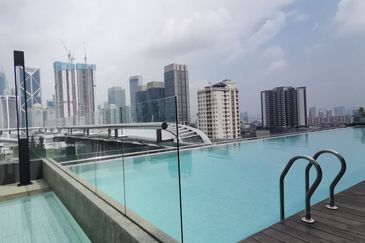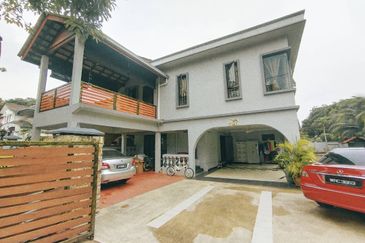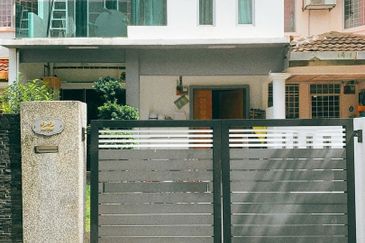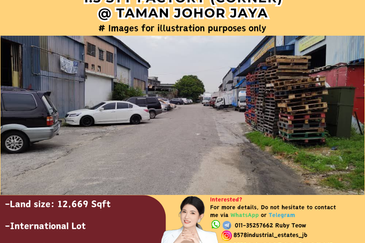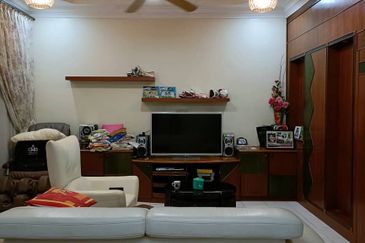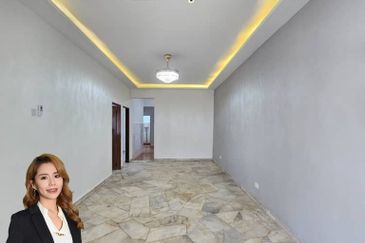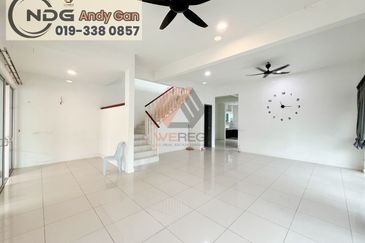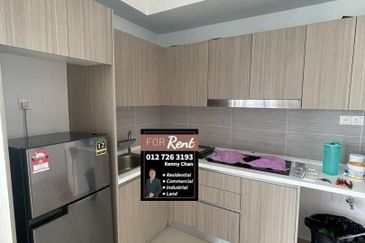S P Setia Bhd will be launching its sixth eco-themed development, Setia Eco Glades in Cyberjaya, next month in a joint venture with Setia Haruman Sdn Bhd. With eight exclusively designed islands and a full array of green features, Setia Eco Glades Sdn Bhd CEO Koe Peng Kang is confident the RM3 billion GDV project will be as well-received as the developer’s earlier efforts.
On a recent tour of Setia Eco Park in Setia Alam, Selangor, in a buggy driven by Setia Eco Park Sdn Bhd CEO Koe Peng Kang, we go past several gardens with different themes and concepts. We spy butterflies, birds and bees flit from one colourful bloom to another, and amid the trees and foliage are fountains and ponds with ducks, swans, fish and other fauna that share the development with its residents.
According to Koe, he and his capable Team Setia — as he affectionately calls those helping develop the 791-acre Setia Eco Park with him — are set to start work on the soon-to-be-launched Setia Eco Glades in Cyberjaya. S P Setia Bhd’s latest eco-themed township development will have an estimated gross development value (GDV) of RM3 billion, says Koe, who is also the CEO of Setia Eco Glades Sdn Bhd. The project is a joint venture between S P Setia and Cyberjaya’s master developer Setia Haruman Sdn Bhd on a 70:30 basis.
Setia Eco Glades will be the developer’s sixth eco-centric project. The first was Setia Eco Park in Shah Alam in 2004, followed by Setia Eco Lakes in Vietnam (2008), Setia Eco Gardens in Nusajaya, Johor Baru (also in 2008), Setia Eco Xuan in Vietnam (2011) and Setia Eco Cascadia in Nusajaya (2011).
If Setia Eco Park, which is only 55% developed, is any indication of how Setia Eco Glades will turn out, then it is well worth waiting for. The 268-acre freehold development, some 30% of which will comprise lakes and green areas, is right next to the 400-acre Cyberjaya Lake Garden.
“We went to see the site at the end of last year and discovered a lot of water bodies with fish and wildlife. A portion of the land was previously a rubber estate while some parts of it had been logged. We got the Forest Research Institute of Malaysia (FRIM) to research the area for us for about six months and it discovered that there were quite a number of forest trees that we could save — about 1,300 trees to be exact. We are using a Big John tree transplanter to ensure the trees are removed and replanted in a proper manner. We will work around the natural undulating terrain,” explains Koe.
The entire township, he adds, will take about six years to complete. To enhance accessibility, the developer has proposed and received approval from the Highway Authority of Malaysia to build an interchange leading to the development from the Putrajaya link, which is directly connected to the North South Central-Link (Elite) and Maju Expressway (MEX). The interchange will cost about RM35 million and when completed, says Koe, Kuala Lumpur will be only 20 minutes away compared with 40 minutes now while the Kuala Lumpur International Airport will be 15 minutes away.
The dream
When the idea for Setia Eco Park was first mooted, it was supposed to be a “valley of dreams”. “A dream is very rewarding provided you can turn it into reality. We have learnt to dream under the leadership of [S P Setia president and CEO] Tan Sri Liew Kee Sin. We want to continue to dream,” Koe tells City & Country.
Setia Eco Park has won several awards, including the International Real Estate Federation (Fiabci) Prix d’Excellence Award for Best Master Plan Development in 2007. Precinct 3 of the garden township was declared Best Residential (Low Rise) Development at the Fiabci Malaysia Property Award 2010. Setia Eco Park also won the global Fiabci Prix d’Excellence Awards in 2011 in the Residential (Low Rise) category.
“Be inspired by what we have around us, recreate and make it even better. We are also looking to go further than we have in Eco Park ... which I think we can,” remarks Koe. However, it is not just about dreaming, but also about executing the dream and being able to sustain it, he comments as we pass a little bridge shaded by a grape vine, a stunning field of sunflowers in full bloom, a rose and Japanese garden and a garden that has been newly planted with local fruit trees in our little buggy.
Setia Eco Park was just a concept back in 2004, founded on Liew’s vision of an eco-based residential enclave. This has not only become a reality, but the bungalows in Precinct 3 of the development that were launched in 2005 at RM910,000 to RM1.6 million were recently transacted at around RM2.9 million. Semi-detached homes that cost RM630,000 to RM700,000 at launch are currently going for around RM2 million. Bungalow lots are now worth RM250 to RM300 psf compared with RM56 psf in 2005. Setia Eco Park is a joint effort of S P Setia, Great Eastern Life Assurance (M) Bhd and the Employees Provident Fund.
Setia Eco Glades
Continuing with the “dream”, Setia Eco Glades comprises what the developer refers to as “the Mainland” and eight “islands”. Each island will have a different heritage theme derived from local and foreign cultures (see sidebars).
For instance, one of the islands is called the Sanctuary of Eastern Heritage, in which the focus will be Malaysian heritage such as the Peranakan culture. Another island, called the Charm of Nusantara, will showcase Balinese architecture. “Bali has beautiful architecture and at one time, it was very popular here and you found it all over,” says Koe. “Now the trend is more towards modern designs but we want to bring back the essence of Balinese design because its appeal is international. Its culture and architecture are beautiful and suited to the tropics.
“It is not about copying from here and there, but about our journey and we have been to these places and are emotionally attached to the [island] themes. For instance, the Isle of Kamares is a Mediterranean theme that was inspired by our trip to Greece and Cyprus. “When S P Setia won an award in Cyprus last year, it sent about 30 of us to the two countries and we experienced the true Mediterranean culture. We went to a beautiful and simple village called Kamares, which inspired us so much that we decided we should recreate it here.”
Other islands within Setia Eco Glades are the Sanctuary of Western Heritage, the Terrace of Verdure, the Glades of Westlake, the Jewels of Grasmere and the Isle of Fantasia, which will be developed at a much later stage.
“We want to leave one island as a heritage for the future. We feel we need to do something to contribute to the cultural richness of this country. So we are going to reserve one island just for that,” explains Koe, who is clearly passionate about the development.
“As you know, property development is highly competitive. Unless you have creativity and innovation, there is no way you can sell at a premium. If you are going for something similar to others, people will tend to overlook and forget what your building looks like. We don’t want that; we want people to remember our architecture.”
The international cultural heritage theme is also in line with the developer’s expansion overseas. “We have gone international and therefore need to look at things from an international perspective. We have gone to London, Australia, China, everywhere. We think we have the edge in terms of our experience of the different types of heritage,” Koe remarks.
When completed, Setia Eco Glades will have 2,400 residences, including super links, bungalows and condos. The developer is looking at those working in the various multinational corporations (MNCs) in Cyberjaya, such as IBM Malaysia Sdn Bhd, Shell Malaysia and HSBC Bank Malaysia Bhd, as potential residents and owners of the hgh-end homes. “MNC staff are made up of people from numerous countries and backgrounds who will appreciate the varied design concepts we have here,” says Koe.
As for its green features, Setia Eco Glades will emulate Setia Eco Park homes in offering landscaped streets, rainwater harvesting, building-integrated photovoltaics (BIPV), east-west house direction and water-efficient sanitaryware. The developer is hoping the development will be certified by Malaysia’s Green Building Index and Singapore’s Building and Construction Authority’s Green Mark.
While Setia Eco Park has a central clubhouse, Koe says each community within Setia Eco Glades will have its own clubhouse, called The Hammock Club. “The hammock signifies relaxing, unwinding and laziness when you’re at home,” Koe says. There will also be eight exclusively designed gardens in Setia Eco Glades. To date, three of the concepts have been completed. The developer is in the midst of coming up with the remaining five.
At their maiden launch in August, the 2-storey linked villas or superlink homes and semidees on the Mainland will be opened for sale. As many as 104 superlink units with a gross built-up of 2,900 sq ft will be offered at an indicative price of RM1.1 million. The homes are in the portion that features a themed garden called Liu Li Garden and which will offer 2 and 2½-storey link villas (219 units).
Some 102 two-storey semidees with a gross built-up of 3,200 sq ft and above will also be available for sale at an indicative price of RM1.7 million in the portion featuring the Lepironia Garden. Here, there will be a total of 184 two and 2½-storey semidees. The developer is looking to offer its own interest-bearing schemes for the sale of these homes.
Koe says in the future launches, bungalows with a land size of 5,500 sq ft and built-up of 4,000 sq ft will be sold at about RM2 million while condos with a built-up of 1,200 to 1,500 sq ft may be priced at RM700,000 to RM800,000.
“We feel that this is the right time for Cyberjaya. It is a slowly maturing township and the infrastructure is already in place. Commercial activities are picking up and colleges/universities are here. We feel it is time to put in some very high-end concept projects here,” he remarks.
“We dream it and we implement it, but at the end of the day, it is our customers who harvest the premium. We told investors about the butterflies, birds and bees at Setia Eco Park. Those who believed us bought the semidees for RM650,000 and now these are worth RM1.6 million. The bungalows that were sold for RM900,000 back then are now being transacted at between RM2 million and RM3 million. Setia Eco Park is no longer a dream, but a reality.”
This article appeared in City & Country, the property pullout of The Edge Malaysia, Issue 920, July 23-29, 2012
TOP PICKS BY EDGEPROP

Aira Residence
Damansara Heights, Kuala Lumpur

Residensi Bintang Shamelin ( Shamelin Star )
Cheras, Kuala Lumpur
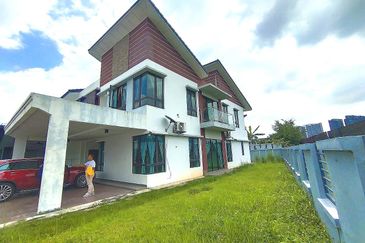
Bandar Setia Alam
Setia Alam/Alam Nusantara, Selangor

Taman Perindustrian Tampoi Jaya
Johor Bahru, Johor
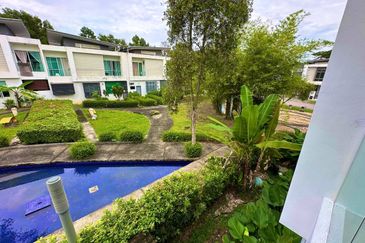
Trillium, Perdana Lakeview East
Cyberjaya, Selangor

Pangsapuri Akasia, Bandar Botanic
Bandar Botanic/Bandar Bukit Tinggi, Selangor

Bandar Bukit Tinggi
Bandar Botanic/Bandar Bukit Tinggi, Selangor

